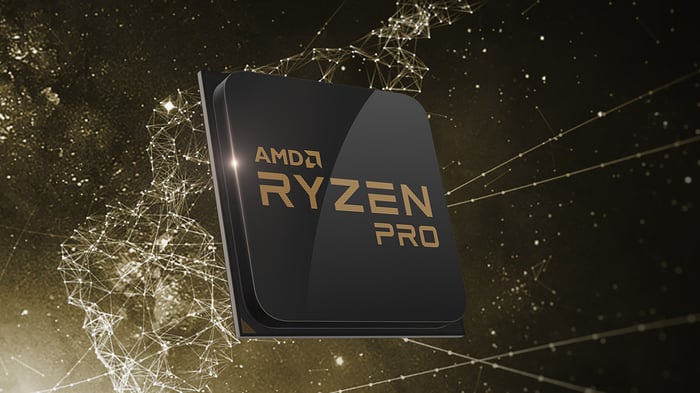AMD (AMD 0.69%) was one of the hottest tech stocks of 2016, surging nearly 430% on its recovering chip sales. But 2017 was a different story. After climbing another 30% by March, the stock stalled out -- and then reversed course following its third quarter earnings report in late October.
AMD has now declined 22% over the past month, erasing all of its year-to-date gains and casting serious doubts on the former tech darling's long-term growth. Let's look back at what went wrong for AMD, and whether or not it can turn things back around.

Image source: Getty Images.
What was the original bull case for AMD?
AMD bulls believed that the company's x86 chipmaking business could challenge Intel (INTC -1.79%) again with its new Ryzen chips, while its discrete GPU business would gain ground against NVIDIA (INTC -1.79%) with its newer Vega-based GPUs.
For a while, it seemed like AMD's plan would work. The new Ryzen CPUs offered performance comparable to that of Intel's current-gen Kaby Lake CPUs at lower prices. Major companies, including Microsoft and Baidu, agreed to install AMD's higher-end Epyc CPUs into their data centers -- which could potentially loosen Intel's near-monopoly on the server chip market. AMD also plans to hit Intel in the mobile market with Mobile Ryzen CPUs, which integrate Vega graphics directly into laptop CPUs.
AMD's new Vega-based Radeon GPUs also offered comparable performance to NVIDIA's current-gen Pascal cards. It also launched a high-end workstation card, the Radeon Vega Frontier Edition, to challenge NVIDIA in the enterprise market. Sales of its GPUs also enjoyed a minor boost from the cryptocurrency mining craze.
Meanwhile, the bulls believed that updated versions of the Xbox One and the PS4 would boost sales of AMD's custom SoCs, which power both consoles. Those three core businesses would prop up AMD's revenue growth, and any seasonal weakness in one could be offset by growth in the others.
So what went wrong?
On the surface, AMD's growth still looks superb. Its revenue rose 25% annually last quarter as its non-GAAP net income surged more than 300%. It also posted a GAAP net income of $71 million, compared to a loss in the prior year quarter. Analysts expect its revenue and non-GAAP earnings to respectively rise 23% and 193% this year.
However, most AMD investors didn't count on Intel and NVIDIA hitting back so hard. Intel initially teamed up with AMD to create Radeon-branded graphics cores and built-in video memory for a new chipset, which seemed like a win-win situation for both companies and a losing one for NVIDIA.
But shortly afterwards, Intel announced the creation of a new Core and Visual Computing group to create discrete GPUs -- and hired Raja Koduri, AMD's former senior president and chief architect of Radeon, as its new leader. This was clearly bad news for AMD and NVIDIA, and both stocks plunged after the announcement.

Image source: AMD.
Intel also introduced its new Coffee Lake chips (the final 14nm Skylake refresh), which pulled ahead of Ryzen again in terms of raw performance in mainstream desktops. Intel's Skylake-X also countered AMD's Threadripper (two eight-core Ryzen CPUs joined by AMD's Infinity Fabric) in the high-end market, albeit at a much higher price.
Meanwhile, AMD's Vega chips offered comparable performance to NVIDIA's Pascal chips, but the prices were also comparable -- which limited their overall appeal. NVIDIA also introduced its next-gen Volta GPU for enterprise users. Once the mainstream version of Volta arrives next year, AMD could struggle to match NVIDIA's blows. Lastly, NVIDIA stole the console show by securing the SoC spot in Nintendo's Switch, which has been outselling the Xbox One and PS4 over the past few months.
So where do we go from here?
Analysts expect these headwinds to throttle AMD's growth, with its revenue and earnings respectively rising 13% and 169% next year. Those numbers aren't bad, but they would represent a significant slowdown from its growth in 2016.
Moreover, the stock doesn't seem particularly cheap at 38 times next year's earnings, which is higher than Intel's forward P/E of 14 but only slightly lower than NVIDIA's forward P/E of 42. As a result, AMD's stock is priced for perfection, but the chipmaker could struggle to meet investors' lofty expectations.





